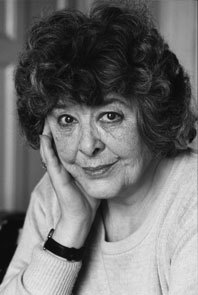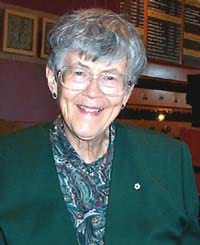
Poul William Anderson was an American science fiction author from the 1940s until the 21st century. Anderson wrote fantasy novels, historical novels, and short stories. His awards include seven Hugo Awards and three Nebula Awards.

Diana Wynne Jones was an English novelist, poet, academic, literary critic, and short story writer. She principally wrote fantasy and speculative fiction novels for children and young adults. Although usually described as fantasy, some of her work also incorporates science fiction themes and elements of realism. Jones' work often explores themes of time travel and parallel or multiple universes. Some of her better-known works are the Chrestomanci series, the Dalemark series, the three Moving Castle novels, Dark Lord of Derkholm, and The Tough Guide to Fantasyland.

The Internet Speculative Fiction Database (ISFDB) is a database of bibliographic information on genres considered speculative fiction, including science fiction and related genres such as fantasy, alternate history, and horror fiction. The ISFDB is a volunteer effort, with the database being open for moderated editing and user contributions, and a wiki that allows the database editors to coordinate with each other. As of April 2022, the site had catalogued 2,002,324 story titles from 232,816 authors.

The Stone Book Quartet, or Stone Book series, is a set of four short novels by Alan Garner and published by William Collins, Sons, from 1976 to 1978. Set in eastern Cheshire, they feature one day each in the life of four generations of Garner's family and they span more than a century.
Helen Cresswell was an English television scriptwriter and author of more than 100 children's books, best known for comedy and supernatural fiction. Her most popular book series, Lizzie Dripping and The Bagthorpe Saga, were also the basis for television series.
Peter Malcolm de Brissac Dickinson OBE FRSL was an English author and poet, best known for children's books and detective stories.
Leo Dillon and Diane Dillon were American illustrators of children's books and adult paperback book and magazine covers. One obituary of Leo called the work of the husband-and-wife team "a seamless amalgam of both their hands". In more than 50 years, they created more than 100 speculative fiction book and magazine covers together as well as much interior artwork. Essentially all of their work in that field was joint.
The Governor General's Award for English-language children's writing is a Canadian literary award that annually recognizes one Canadian writer for a children's book written in English. It is one of four children's book awards among the Governor General's Awards for Literary Merit, one each for writers and illustrators of English- and French-language books. The Governor General's Awards program is administered by the Canada Council.

Monica Hughes was an English-Canadian author of books for children and young adults, especially science fiction. She also wrote adventure and historical novels set in Canada, and the text for some children's picture books. She may be known best for the Isis trilogy of young-adult science fiction novels (1980–1982).
Sylvia Louise Engdahl is an American writer, known best for science fiction. Her debut novel Enchantress from the Stars, published by Atheneum Books in 1970, was the 1971 Newbery Honor Book, was a Geffen Award finalist in 2008, Best Translated YA Book, and she won the Phoenix Award for that work twenty years later.

Jane Johnson is an English writer of books for adults and children and fiction book editor. As a writer she has used the pseudonyms Gabriel King, jointly with M. John Harrison, and Jude Fisher, as well as her real name.

The Dark Lord of Derkholm, simply Dark Lord of Derkholm in the United States, is a fantasy novel by the British author Diana Wynne Jones, published autumn 1998 in both the U.K. and the U.S. It won the 1999 Mythopoeic Fantasy Award for Children's Literature.

The Guardian of Isis is a young adult novel by Monica Hughes, and is the sequel to The Keeper of the Isis Light. The story takes place on the fictional world of Isis. It is set 55 years after the first book, and now two more generations have been born.

The Isis Pedlar is a young adult science fiction novel by Monica Hughes, the third in the Isis series, following The Guardian of Isis. It was first published in 1982.

Paolo Tadini Bacigalupi is an American science fiction and fantasy writer. He has won the Hugo, Nebula, John. W. Campbell, Compton Crook, Theodore Sturgeon, and Michael L. Printz awards, and has been nominated for the National Book Award. His fiction has appeared in The Magazine of Fantasy & Science Fiction, Asimov's Science Fiction, and the environmental journal High Country News. Nonfiction essays of his have appeared in Salon.com and High Country News, and have been syndicated in newspapers, including the Idaho Statesman, the Albuquerque Journal, and the Salt Lake Tribune.

The Pinhoe Egg is a children's fantasy novel by British author Diana Wynne Jones published by HarperCollins Children's Books in 2006. It was the last published of the seven Chrestomanci books.
Maureen Mollie Hunter McIlwraith was a Scottish writer known as Mollie Hunter. She wrote fantasy for children, historical stories for young adults, and realistic novels for adults. Many of her works are inspired by Scottish history, or by Scottish or Irish folklore, with elements of magic and fantasy.

Enchantress from the Stars is a young adult science fiction novel by Sylvia Engdahl. It was her first or second book and is set in the Anthropology Service universe. Its sequel The Far Side of Evil (1971) features the same heroine, Elana, and the two are sometimes called the Elana series, although the sequel is quite different in tone.

The New Policeman is a children's fantasy novel by Kate Thompson, published by Bodley Head in 2005. Set in Kinvara, Ireland, it features a teenage boy, J. J. Liddy, who learns that "time is leaking from his world into Tir na nOg, the land of the fairies". It inaugurated a series that is sometimes called Liddy.

Monsters of Men is a young-adult science fiction novel by Patrick Ness, published by Walker Books in May 2010. It is the third book of the Chaos Walking trilogy inaugurated two years earlier by The Knife of Never Letting Go. Walker's U.S. division Candlewick Press published hardcover and audiobook editions within the calendar year.














